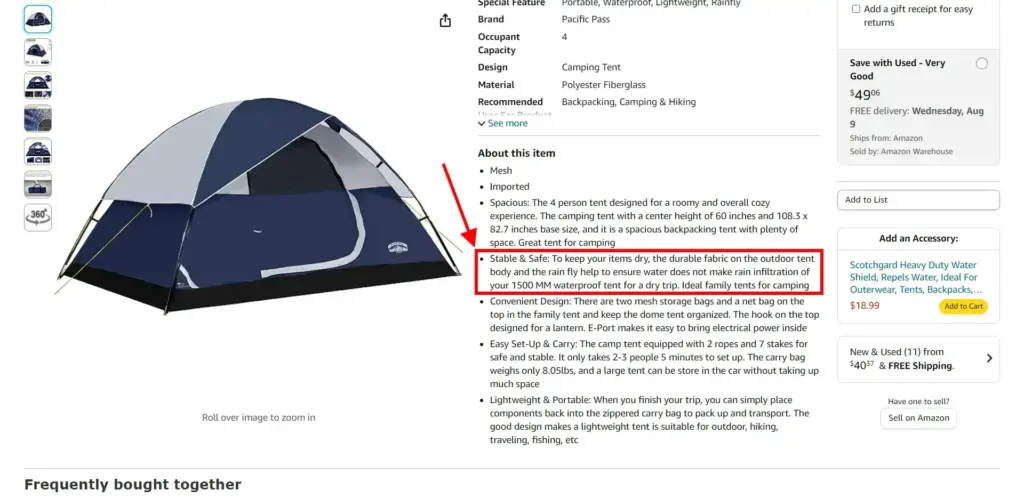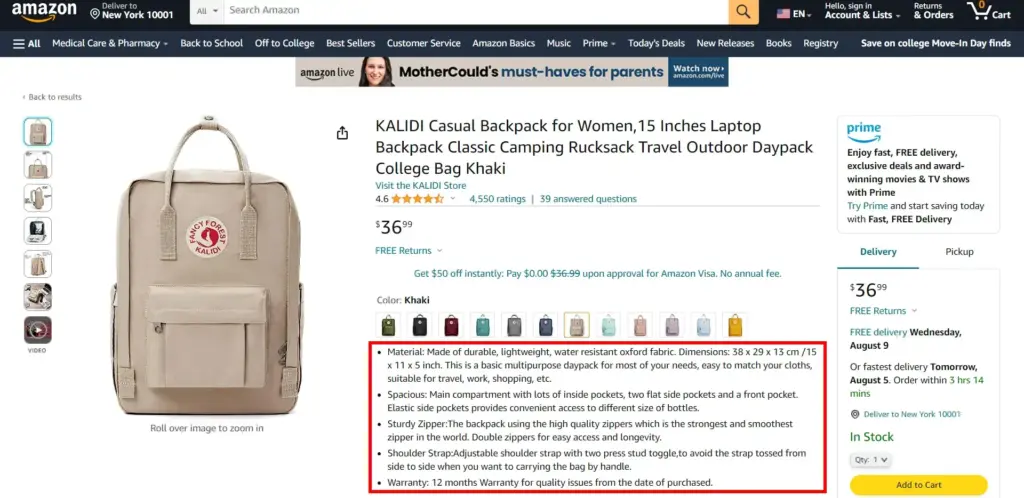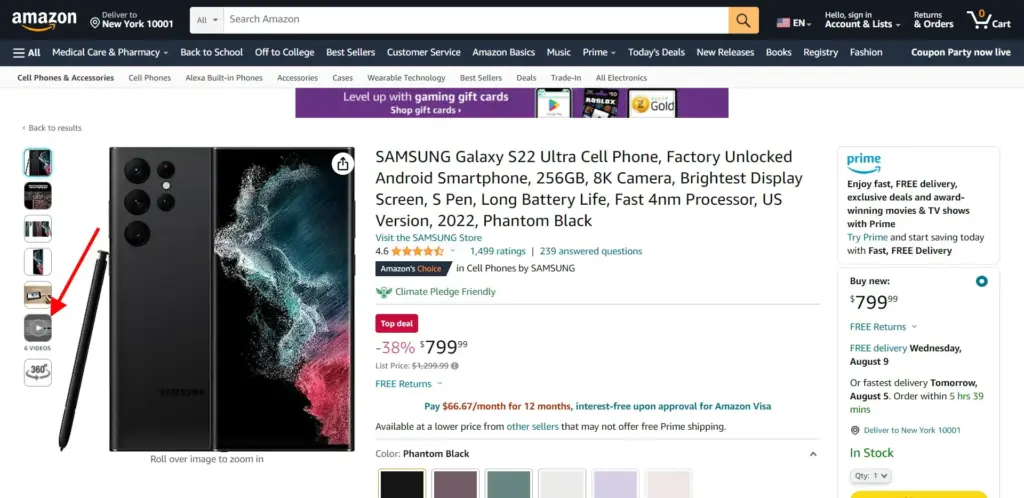A powerful Amazon product description doesn’t just reiterate the same facts about the goods from one page to another. It’s an effective way to persuade users to buy the item from your store and connect with them on a deeper level than your competitors. Many sellers miss this opportunity. As a result, we come across similar descriptions that are bland, shallow, or too technical.
No wonder shoppers start to look for other reasons to buy a product, like reviews or the company’s trust signals. But product descriptions aren’t a formality to overlook. With the right wording and other tricks, you can turn them into sales leverage and boost conversion rates.
In this article, we’ll shed light on how to write Amazon product descriptions. We’ll provide real-world examples to help you strike a balance between informative details, understanding your audience, and leveraging Amazon’s platform. Ready to optimize your Amazon listings? Let’s begin!
Understanding Amazon’s Algorithm (A9)
How does Amazon decide which products to place higher in search results? Similar to search engines like Google, it relies on search algorithms, i.e., A9. However, this alternative is broader than the informational results provided by Google. A9 aims to dissect keywords, price, and sales history to determine the products users will most likely buy.
And while fantastic ratings and excellent photos are unquestionably important, many vendors neglect Amazon product description writing. A well-optimized description serves both the A9 algorithm and potential customers. It helps them find your product to be more relevant.
By providing better context, the algorithm can easily comprehend the essence of the product helping it rank higher for related queries. At the same time, a higher ranking leads to more clicks and sales, enhancing your positions even more. It’s a reciprocal process. Keep reading as we dive into 5 helpful tips for creating high-converting product descriptions.
5 tips to Create the best Product Descriptions
Tip 1: Know Your Audience
The first thing you should consider is the language your audience speaks. Why do you need it? The reason is that you would treat a gaming geek differently compared to a busy mother of two children, right? So in order to appeal to the appropriate group, you need to begin by analyzing your buyer inside out.
Who is the ideal customer for your product? What will persuade them to make the purchase? How do they plan to use it? The more details you can gather about your ideal consumer profile beforehand, the more powerful your listing will be. You may determine what customers value most about a product by taking the following steps:
- Conducting market research
- Reading customer reviews that have already been written about it
- Googling it
- Looking at what others are saying about it on blogs, social media, and online forums.
Tools like Amazon Brand Analytics offer invaluable insights into search terms and demographics.

So once you’ve collected the necessary information, write descriptions for Amazon with the audience in mind:
- Address buyers using “You”
- Imagine talking to a client in person and note down the details you’d mention when describing the product
- Don’t just discuss the benefits of the product; mention the issues that matter to them
- Answer common questions that are relevant to the product
Tip 2: Highlight Key Features
The next step when writing descriptions for Amazon is to reduce extensive text and only list key features. It may be tempting to enumerate all possible details, but consumers have a limited attention span. Some may even make a purchase on the go from smartphones.
After all, they’ve come to buy, not read long stories. That’s where you need to learn how to highlight key features in the Amazon product description without sacrificing essential details.
What benefits can a consumer gain from buying this product? Think of a tent for a camping trip as an example. It may consist of a “water-resistant material,” which is a perk. But what does that entail for the camper? The benefit is “Stay dry and cozy, even during unexpected downpours.”

Keep in mind the following takeaways:
- How a product can actually solve a customer’s problem
- How it might be of any use to them
- What makes it better than similar goods that deserve the shopper’s attention
To make the process easier:
- Begin by listing all the features.
- Pick out 3 or 4 essential ones and ask yourself, “So what?”
- Whether a product is good for health or easy to apply, make it enticing and relatable to users.
- You can also use a Amazon listing analyzer to assist this process
Top 3: Optimize for Keywords
Even the most effective Amazon product description means nothing if people can’t find it. So the next consideration on your list should be making yourself more discoverable to search engines and buyers. You can achieve this by adding SEO to your writing. Here is where keyword optimization comes into play.
Inputting the exact product name doesn’t count here. You need to be aware of search terms and the unique word combinations consumers use when looking for products similar to the ones you sell. Now, delving into the specifics of the Amazon algorithm can be confusing. But there are various optimization tools Viral Launch offers to streamline these processes. For instance, the Keyword Research Tool to research your markets and discover trending keywords, ensuring your product remains at the forefront of customer searches. This information is crucial to increasing your sales.

Identify the top 10–20 trending things in relevant categories and pay attention to their titles and descriptions. Also, utilize long-tail keywords four or more words, such as “women’s waterproof hiking shoes” rather than more broad terms like “shoes,”. This can lead to increased visibility.
Tip 4: Use Clear and Concise Language
As mentioned above, Amazon shoppers aren’t typically diving deep into every word you write. They’re skimming, scanning, and making quick decisions. So, how can you ensure they get the most out of your descriptions?
- Break it down: Use short sentences to make it faster to spot important information without reading every word.
- Headings & subheadings: Make them clear. They direct readers and make sure they remember the critical details.
- Bullet points: You can include up to five bullet points in the “About the product” section. Note that they should be no longer than 150-200 characters and deliver the essence of the product.
- Character count: Keep the Amazon product description under 2,000 characters to retain shoppers’ attention.
The seller, from this example below, diligently follows the tips mentioned above.

A quick heads-up to all sellers to stay updated with Amazon best practices. Starting June 6, 2023, you’ll have to provide information for certain product categories, such as:
- Color name
- Size name
- Other essential attributes that were previously optional
Tip 5: Utilize High-Quality Images and Videos
Apart from text, you can persuade users to buy with the help of images and videos. These are the unsung heroes of product listings. Let’s face it: no matter how much you’ve read about the product, it’s visuals that can move the needle, especially in eCommerce.
Images
Customers can access them when clicking through to your Amazon product page. Ensure their high quality resolution, and compliant with Amazon best practices. For example, they should show your product from various angles, but you can’t add more than seven to nine photographs.
Use a white background for the main image (as per Amazon’s guidelines) to make it professional. However, lifestyle pictures are also important as they demonstrate the goods in use. This helps customers visualize the product and imagine them in real life.
Videos
Videos don’t just let you visualize the product instead of jotting down all of its features. They also enable you to tell a whole story. According to a recent study by Wyzowl, up to 91% of customers want brands to produce more videos. That’s why more and more sellers integrate videos into their Amazon descriptions.
A video may feature products, their capabilities, benefits, and use cases. Your task is to take care of the proper lighting, script, and camera. Below you can see that the seller includes even six videos and the ability to view the phone in 360°.

Amazon A+ Content (formerly Enhanced Brand Content)
It’s a feature that supports a richer content format. By using it, you can add more images and other product details. For example, you can add detailed product comparisons and more immersive visuals. This feature helps gives you more freedom to tell the story of your product. Amazon claims that Amazon A+ Content can improve conversions by 3-10%.
Bonus Tip: Engage with Customer Reviews and Q&As
Your work doesn’t stop after writing descriptions for Amazon. The next step is to sustain communication with your clients and analyze their feedback and questions. Monitor reviews and the Q&A section, timely step in, and thank customers for taking the time to comment on your products. Respond to criticism in a positive way.
Through continued interaction, you can establish trust and learn about possible improvements. For instance, it may inspire you to conduct a CRO website audit to see where you may miss out on sales opportunities. Or you may even want to enhance your product by adding new features.
Common Mistakes to Avoid When Writing Amazon Product Descriptions
As you can see, an Amazon product description goes beyond inserting a few random keywords. It involves a thorough review of your audience, product benefits concerning customers’ needs, and taking quality photos and making videos. Some pitfalls to avoid when organizing your Amazon product page include the following:
- Being vague: It’s easy to fall into a trap and say that your product is great. But what makes you think so? Be transparent and honest and focus on customers, not the product.
- Ignoring formatting: Fluff or misleading information disorganizes readers. They harm conversions. Take advantage of the available space while writing as briefly as possible.
- Overstuffing keywords: Keyword stuffing happens when you cram too many terms into your text. While it doesn’t boost traffic, it may spoil content readability and page rankings. Excessive keywords may obscure essential information, making the description too unnatural. What’s worse, search engines consider this strategy to be spam.
- Neglecting proofreading: Double-check Amazon descriptions to eliminate typos and grammatical errors, as they can undermine trust and credibility.
- One-size-fits-all approach: Target a specific person or audience segment when writing descriptions for Amazon. Adjust content and tone of voice depending on the product. Make “you” and “your” go-to words during this process. Write using language that your ideal customer would understand.
Conclusion
In conclusion, product descriptions are much more significant than many people realize. They present the product in the best possible light, provide your customers with all the relevant details, and can support your SEO efforts. We’ve taken a glance at some Amazon best practices; let’s revisit the essentials:
- Research your target audience.
- Highlight key features and how they translate into tangible benefits for potential customers.
- Use keywords but in a natural way.
- Don’t over complicate your text.
- Include visuals that catch the eye to enhance your writing.
The bottom line is that writing quality descriptions is something worth investing time in. Remember to avoid duplicate text and use your creativity! Viral Launch will be there to help, from keyword research to listing optimization, and everything in between.








